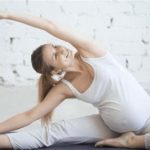Essential Yoga Poses for Expecting Mothers: A Guide to Safe Practices
Yoga during pregnancy offers numerous benefits, including improved flexibility, strength, and relaxation. However, expecting mothers need to approach their practice with caution. This article explores five safe yoga poses specifically designed for pregnant women, ensuring both safety and effectiveness.
Key Concepts
- Adaptability: Poses should be modified to accommodate the changing body.
- Breath Awareness: Focus on deep breathing to promote relaxation and reduce stress.
- Alignment: Maintaining proper alignment helps prevent injury and discomfort.
- Connection: Yoga can enhance the bond between mother and baby.
Historical Context
Yoga has been practiced for thousands of years, with origins tracing back to ancient India. Traditionally, it was seen as a holistic approach to physical and mental well-being. In recent years, prenatal yoga has gained popularity, specifically tailored to meet the needs of pregnant women. Research shows that prenatal yoga can alleviate pregnancy-related discomforts, reduce anxiety, and prepare women for labor.
Current State Analysis
Currently, many healthcare providers recommend yoga as part of a prenatal wellness program. The American College of Obstetricians and Gynecologists (ACOG) supports moderate exercise during pregnancy, including yoga. However, women are encouraged to consult their healthcare providers before beginning any new exercise regimen.
Practical Applications
Incorporating yoga into a prenatal routine can provide both physical and emotional benefits. It can help alleviate common discomforts such as back pain, swelling, and fatigue. Moreover, practicing mindfulness through yoga can enhance emotional well-being and prepare mothers for the challenges of motherhood.
Safe Yoga Poses for Pregnant Women
1. Cat-Cow Stretch
This gentle flow between two poses warms the spine and relieves back tension.
| Steps | Benefits |
|---|---|
| Start on hands and knees, aligning wrists under shoulders and knees under hips. | Improves spinal flexibility. |
| Inhale, arch your back, and lift your head (Cow Pose). | Stretches the abdomen and chest. |
| Exhale, round your spine, and tuck your chin (Cat Pose). | Relieves lower back tension. |
| Repeat for 5-10 cycles. | Encourages relaxation and deep breathing. |
2. Child’s Pose
A restorative pose that promotes relaxation and helps relieve tension in the back.
| Steps | Benefits |
|---|---|
| Kneel on the floor and sit back on your heels. | Provides a gentle stretch for the spine. |
| Extend your arms forward on the floor, or rest them by your sides. | Calms the nervous system. |
| Hold for 5-10 breaths. | Reduces anxiety and stress. |
3. Warrior II Pose
This standing pose builds strength and stability while promoting focus and endurance.
| Steps | Benefits |
|---|---|
| Stand with feet wide apart, turning your right foot out. | Strengthens the legs and core. |
| Bend your right knee over your right ankle and extend your arms out to the sides. | Enhances balance and concentration. |
| Hold for 5-10 breaths and switch sides. | Increases stamina and confidence. |
4. Tree Pose
This pose improves balance and stability, helping to ground the body and mind.
| Steps | Benefits |
|---|---|
| Stand tall and shift weight onto your left leg. | Enhances concentration and focus. |
| Place your right foot on your left inner thigh or calf (avoid the knee). | Strengthens the legs and core. |
| Bring hands to heart center or raise them overhead. | Improves posture and body awareness. |
| Hold for 5-10 breaths and switch sides. | Promotes inner peace and stability. |
5. Seated Forward Bend
This calming pose stretches the back and hamstrings while promoting relaxation.
| Steps | Benefits |
|---|---|
| Sit with legs extended in front, feet flexed. | Stretches the spine and hamstrings. |
| Inhale and lengthen your spine, then exhale and gently fold forward. | Encourages relaxation and reduces anxiety. |
| Hold for 5-10 breaths. | Calms the mind and body. |
Case Studies
Research indicates that prenatal yoga can lead to positive outcomes for both mothers and babies. A study published in the Journal of Alternative and Complementary Medicine found that pregnant women who practiced yoga reported lower levels of stress and anxiety. Another study in Obstetrics & Gynecology highlighted improved sleep quality among participants who engaged in regular yoga practice.
Stakeholder Analysis
Various stakeholders are involved in the implementation of yoga for pregnant women, including:
- Healthcare Providers: They can recommend yoga as part of prenatal care.
- Yoga Instructors: Must be trained in prenatal yoga to ensure safety.
- Expecting Mothers: Their comfort and safety should always be prioritized.
- Family Members: Support from family can enhance the yoga experience.
Implementation Guidelines
When practicing yoga during pregnancy, consider the following guidelines:
- Consult with a healthcare provider before starting any new exercise regimen.
- Seek a certified prenatal yoga instructor to ensure proper techniques.
- Listen to your body and avoid pushing past your limits.
- Modify poses as needed to accommodate your growing belly.
- Focus on relaxation and mindfulness rather than perfection in poses.
Ethical Considerations
It is crucial to ensure that yoga practices are inclusive and accessible to all expecting mothers. Instructors should be aware of the diverse backgrounds and experiences of their students, fostering an environment that promotes safety and respect. Moreover, the potential for misinformation regarding prenatal yoga practices should be addressed, ensuring that all advice is evidence-based and tailored to individual needs.
Limitations and Future Research
While many studies support the benefits of prenatal yoga, more extensive and longitudinal research is needed to fully understand its long-term effects on maternal and fetal health. Future research should focus on:
- The psychological effects of prenatal yoga on maternal mental health.
- The impact of different yoga styles on pregnancy outcomes.
- Long-term benefits for mothers and babies post-delivery.
Expert Commentary
Yoga provides a powerful tool for expecting mothers, promoting physical and emotional well-being. By understanding the safe poses and following ethical guidelines, pregnant women can enjoy the numerous benefits of yoga while preparing for motherhood.








